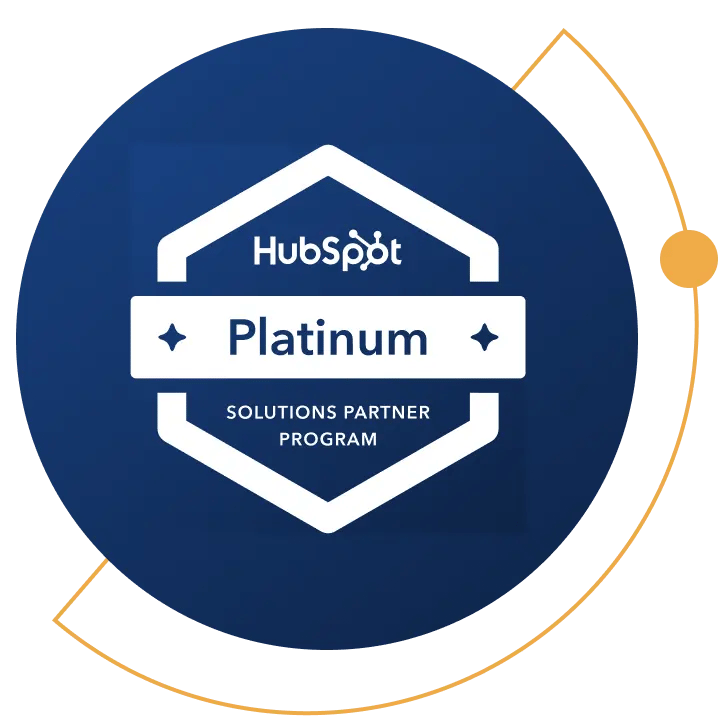HubSpot Partner Onboarding 101
Once you’ve decided to make HubSpot the sales and marketing solution for your business, you will need to complete the onboarding process onto the HubSpot platform. This process encompasses the technical set-up of your account and services, the workflows to automate your inbound marketing efforts, the custom templates and tracking parameters, and importing your existing customer data.
Each onboarding process differs between businesses, as each business has unique objectives, things they want to measure and track, and business models. The onboarding process is the time to create a solid foundation on which to build your inbound marketing strategy and scale your business to success.
Why is HubSpot Onboarding required?
There is simply no way you could sign up for HubSpot and it will automatically design custom workflows, templates, and upload your entire business data network automatically. (But that would be cool!) As with all accounts, software, and services, some sort of set-up is required, and that is what the onboarding process is.
You have two options on how your business decides to get started on the HubSpot platform, as you’ll read below. Just as your business is unique and custom, how you decide to onboard with HubSpot is entirely up to you.
A successful onboarding will create systems that make your existing work more efficient so you can focus on running your business, and let the automated custom workflows do the work for you. An unsuccessful onboarding could be time-consuming, or leave you chasing integration errors as you learn the nuances of the HubSpot platform. It also could limit the potential of your business’s growth, as you risk not utilizing all of the tools and custom solutions available to you while you learn about all the capabilities of HubSpot solutions.
We should also mention that this is highly specific on which HubSpot products you plan to invest in.
For example, if you're considering something like HubSpot's Marketing Hub, then it helps to work with a HubSpot Web Design Agency (like Vaulted) with experience in both web design and HubSpot. However, some HubSpot products are more centric to automation and workflows and, thus, the customized onboarding can be slightly different from each product.
When onboarding with HubSpot, you can choose to do the work yourself directly, or choose a HubSpot Partner or Agency to do the onboarding process for you.
Onboarding Without a HubSpot Partner
If you choose to onboard with HubSpot directly, you will be assigned a HubSpot Implementation Specialist to help guide you through the process for the first 90 days of your subscription. This agent will be there to answer questions as you follow the steps of the onboarding process through the platform, and will also assist you in creating your first campaign with HubSpot software.
The HubSpot platform and its potential can be a bit overwhelming at first, and even with their directions and guides, the technical integrations (including a tech stack audit) and logistical set-up can get confusing, so having someone to ask questions along the way is helpful.

The HubSpot Implementation Specialist is a supporting role, however. So you will be responsible for the full technical set-up and transferring, workflow and template design, and software integration, as well as training your team on how to use the HubSpot workspace.
Using a HubSpot Partner or Agency for the Onboarding Process
When using a HubSpot Partner for the onboarding process, you will be bringing an expert onto your team to create a custom HubSpot solution for your business. They’ll know the ins and outs of the technical set-up which will save you time and energy, and give you confidence in the foundation of your inbound strategy. They’ll also work with you to create a custom HubSpot integration, rather than the cookie-cutter or off-the-shelf solutions you’re likely to get with HubSpot’s guided support.

Book a Free HubSpot Strategy Call
Talk 1-on-1 with a certified HubSpot expert and get tailored, no-pressure recommendations—completely free.
With an expert on your team, your HubSpot partner will make the onboarding process efficient and custom to your business’s unique objectives. All this will be done without taking your time away from operating your business to integrate the HubSpot platform.
What is the onboarding process like with a HubSpot Partner Agency?
What to Expect: Steps of the onboarding process
The first step of the onboarding process is understanding how HubSpot can help your business, and which of its tools will benefit you most. This is done by chatting with you and your team to gain a thorough view of your business now, and where you’d like it to be. Choosing someone from the HubSpot Solutions Partner Program will then apply their expertise and knowledge of the platform to design an inbound strategy to meet your goals.
First is technical and strategic guidance to integrate with existing tools and platforms, set-up your tracking and measuring parameters per your unique objectives, and making sure the backend of the platform is solid without any bugs or errors that might plague you later. This step, alone, will save you hours of reading tutorials on setting up your HubSpot account on your own.

After gaining an understanding of your business’s objectives and building a fully-integrated foundation, your HubSpot Solutions Partner will then get to work developing the custom workflows that will automate your business and marketing efforts. This is where having a HubSpot partner for the onboarding process will provide true value to your HubSpot solutions - using their familiarity to find the most efficient and customized solutions for your business.
Finally, it is time to transfer your existing data into the platform and see the magic of HubSpot’s automated workflows. The amount of time for this stage will depend on the amount of data you have, as well as the current platform or format that the data currently exists.
How long does onboarding take?
The length of onboarding will depend on the size of your business, the size of your team, and the amount of data that already exists in your current CRM that needs to be transferred. But, generally speaking, the benchmark for most accounts is 90 days.
The amount of HubSpot solutions your business is looking to incorporate will also influence how long the onboarding process will take, as well as how granular and customized the workflows need to be in order to reach and measure your unique goals.
However much time it will take for the transfer, design, and set-up of the HubSpot on your own - it will typically take significantly less time (and headache) to work with a HubSpot Solutions Partner for the process.
What value does a HubSpot Partner bring to the onboarding process?
As a HubSpot Solutions partner, we are here to save you time and energy on the tedious task of onboarding your business to the HubSpot platform. With our knowledge and expertise gained through years of HubSpot experience, we can give you a custom automated inbound strategy that’s ready to work for you immediately. You’ll still be trained on how to manage and use these workflows, but there’s no need to spend your time learning the one-time process of onboarding.
When you use a qualified and experienced partner for your onboarding, you can continue to run your business, and we’ll hand over a ready-to-operate solution for your inbound strategy or sales process that is completely customized for you.
One of the core tools for this at Vaulted is our onboarding plan. The onboarding plan is a customized plan for both onboarding and implementation that we complete as part of every project. Not only does this plan create clear expectations about completing your onboarding within 90 days of engagement, but it allows you to speak to your objectives and goals.
Choosing the Right Onboarding Process for You (Agency/Partner vs. HubSpot direct)
The difference between onboarding directly with HubSpot yourself and having a HubSpot Partner or Agency do the onboarding process for you is a bit like filing your taxes. As a competent business owner, you are completely capable of following the directions to file your taxes correctly, as tedious as it may be.
Even so, unless you are in the business of filing taxes, there is a higher risk of making a mistake, missing a write-off, or being up-to-date on every new tax law and write-off that applies to your business.
When you hire an expert to do your taxes, you can just hand off the work, and let them apply their knowledge and expertise to file everything accurately and find every benefit to your business. This keeps your business operating at full speed so you don’t take time and energy from your business to file taxes once a year.

HubSpot onboarding is similar in this way. Doing the onboarding process yourself might be the best option for you and your team if you’re interested in becoming a HubSpot expert to know the ins and outs of the platform and utilize it in a custom way for your business’s success. It’s a steep learning curve at first, but with the support agent assigned to you, you can be using HubSpot and implementing your inbound strategy with success on your own.
However, hiring a HubSpot Partner (and expert) to provide you with customized onboarding process for you, means that you can just hand over the data and your business objectives (like growing your traffic), and let the expert utilize their knowledge and expertise to create a custom inbound marketing solution for your business. They’ll dig deep into the HubSpot platform, and let you focus on the management of your business in the meantime. The result is guaranteed to be faster, more efficient, and more effective because you have an expert on your team.
You and your business are unique and you know what is best for you. If you are interested in what the unique onboarding process for your business with a HubSpot partner would look like, we’d love to chat.

Jump-Start Your HubSpot Rollout
Book a complimentary, 30-minute discovery call with a Vaulted onboarding strategist.
Frequently Asked Questions
1. What exactly is HubSpot onboarding?
It’s the structured set-up period—normally the first 90 days—where your portal is connected to your existing tech stack, custom objects and properties are created, data is imported, and the first automated campaigns and reports come to life. Think of it as pouring the foundation before you frame the house; get it right and everything else stands straight.
With Vaulted, onboarding and implementation happen in parallel. While our specialists handle the technical build-out, we’re also walking your team through every key decision—field mappings, pipeline stages, permission schemes, integration settings—so you understand the trade-offs and pick the smartest configuration for your growth plans. Alongside that education, we deliver clear strategy recommendations that move you quickly from “new portal” to “operational CRM” so users start logging calls, moving deals, and building real muscle memory in HubSpot from day one.
2. Do I really need onboarding if my team is tech-savvy?
Technical skill shortens the learning curve, but onboarding isn’t only about clicking the right buttons. It establishes the structural footing your CRM will rest on for years—deal stages, lifecycle touchpoints, data-hygiene rules, permission sets, and reporting views that every department will rely on. Neglect that groundwork and you’ll be back-tracking later to untangle misaligned fields or retrofit workflows.
Your internal team already has its hands full absorbing a mountain of new concepts and coaching colleagues to use the system day-to-day. Offloading the technical build lets them focus on change management while Vaulted handles the architecture. For that reason, both Vaulted and HubSpot recommend—and HubSpot typically requires—professional onboarding for every new portal, ensuring the foundation is poured once, correctly, instead of in a rush six months down the road.
3. How does Vaulted’s onboarding differ from HubSpot’s direct onboarding?
HubSpot’s Implementation Specialists offer structured guidance—checklists, office hours, best-practice articles—but your internal team is still on the hook for building pipelines, mapping fields, writing email sequences, and troubleshooting integrations. That “do-it-with-support” model can be more budget-friendly, yet it demands significant in-house hours and lots of context-switching during a period when everyone is already soaking up new terminology and processes.
Vaulted was designed for teams that would rather keep their heads in day-to-day operations while experts get the portal production-ready. We pair strategic consulting and hands-on execution: digging into your buyer journey, selecting the right objects and properties, wiring apps, creating workflows and sequences, and even drafting the content those automations send. Because our bench includes RevOps engineers, content marketers, and sales-enablement writers, you don’t just receive a configured CRM—you inherit battle-tested collateral that launches alongside it.
The result is a true white-glove rollout that (1) compresses the go-live timeline, (2) lets your staff stay focused on their regular responsibilities, and (3) leverages industry experience we’ve accumulated across similar business models to sidestep rookie missteps. HubSpot delivers advice; Vaulted delivers the finished product—plus the tutorials so your team can drive confidently the moment the keys are in hand.
4. What’s included in Vaulted’s onboarding plan?
Vaulted treats onboarding as both a build-out and a guided learning track. While our RevOps engineers wire the portal, our strategists run weekly workshops that unpack why each decision matters—so your team isn’t just getting a shiny new CRM, they’re absorbing the logic behind its architecture. The program also bakes in feature-adoption milestones, pacing the rollout of tools like Playbooks, Sequences, and Custom Reporting so users can master one capability before the next unlocks.
Here’s a snapshot of what we deliver:
-
Technical audit of your existing CRM, forms, site, and data flows
-
Portal configuration (users, permissions, custom objects, properties)
-
Data migration & hygiene checks
-
Workflow and pipeline design for sales, marketing, and service
-
Tracking setup (events, UTMs, analytics dashboards)
-
Weekly strategy workshops + on-demand video walkthroughs
-
Progressive feature-adoption roadmap with usage targets and KPIs
5. How long will the onboarding process take for my business?
Our published benchmark— 90 days —assumes a single-hub rollout (for example, HubSpot Marketing Hub or HubSpot Sales Hub) with fewer than 20 active users and a manageable asset library (under 10,000 contacts, a few dozen campaigns, and light automation). Once we introduce heavier variables—large content migrations, multi-hub suites that include HubSpot Service Hub, Operations Hub, or CMS Hub, or a user base that pushes past 50 seats—the schedule stretches. For true Enterprise-tier portals, expect the timeline to run beyond the three-month mark, especially when custom objects, complex permission hierarchies, and deep third-party integrations enter the mix.
Beyond raw scope, the pacing hinges on how quickly real users adopt the system. Vaulted bakes “people readiness” into every plan: we run a pre-launch knowledge audit to surface gaps, schedule weekly hands-on workshops to close them, and circle back with a post-launch health check that verifies log-ins, pipeline usage, and workflow engagement. If adoption lags, we adjust the curriculum or add extra office hours rather than letting the calendar dictate “done.” In short, 90 days is the target for most small-to-mid teams, but the finish line ultimately depends on content volume, seat count, and how fast your crew turns new features into daily muscle memory.
6. Can we add more HubSpot hubs later without starting from scratch?
Yes. Sales Hub, Marketing Hub, Service Hub, Operations Hub, and CMS Hub all live on the same CRM foundation, so the objects, properties, and integrations we configure today stay intact when you turn on another hub tomorrow.
Each hub does introduce its own specialty tools—Service Hub’s ticket pipelines and custom ticket properties, for instance, or Operations Hub’s data-sync recipes. Those components still need to be activated, permissioned, and connected to your existing automations. Vaulted scopes that incremental setup, builds the new pieces, and maps them back to your current data model so expansion feels like an upgrade, not a rebuild.
8. How involved does my team need to be?
Expect a single 45- to 60-minute virtual session each week. That call covers sprint goals, live demos of what was shipped, and a quick backlog review. In between, we send concise email status notes—so most stakeholders stay in the loop without living in meeting rooms.
We keep wider participation lightweight by running short qualitative surveys when big-picture feedback is needed, letting us capture sentiment without dragging twenty people onto a Zoom call. Subject-matter experts and primary stakeholders (for example, your Chief Marketing Officer when we define lifecycle stages) do step in more often; their insights steer critical configuration choices that shape long-term adoption. Outside of those targeted touchpoints, your team can focus on normal operations while we handle the build.
9. What situations stall DIY HubSpot rollouts the most?
9. What situations stall DIY HubSpot rollouts the most?
Even capable teams sometimes grind to a halt—not because the platform is too technical, but because the decision-making around it gets messy. Below are four patterns we routinely untangle:
-
One-field-to-rule-them-all syndrome
Trying to cram complex information (SKUs, regions, buyer personas) into a single “Notes” field leaves you no way to segment, trigger automations, or report accurately. We help clients break data into the right objects and properties so a single value change can fire a workflow, feed a dashboard, or personalize an email—without manual wrangling. -
Analysis paralysis
Some teams read every knowledge-base article, join every user group, and still freeze when it’s time to pick a lifecycle model or pipeline layout. They know how to execute but lack the context to choose which option serves the strategy. Vaulted provides guardrails and best-practice frameworks so decisions happen in hours, not weeks. -
Granularity gone wild
Creating five separate deal pipelines because you sell five SKUs sounds tidy—until reps have to memorize five sets of stages and managers juggle five different forecasts. We show where consolidation beats fragmentation and reserve extra pipelines for truly distinct motions (e.g., new business vs. renewals). -
Consensus gridlock
Marketing wants one lead-status model, Sales wants another, and Operations sits in the middle. Without a neutral facilitator, debates drag on and portal setup stalls. Vaulted comes in as the third party who can translate goals into clear technical choices and push the project forward with an objective tie-breaker.
By spotting these roadblocks early—and having an outside expert steer through them—you keep momentum high and see value from HubSpot far sooner.
10. How do we measure the ROI once HubSpot is live?
Because HubSpot consolidates marketing, sales, and service data under one roof, it’s straightforward to run year-over-year comparisons against the numbers that lived in your previous CRM—or against the “before HubSpot” spreadsheets if this is your first true system of record. Vaulted migrates or reconstructs those historical metrics during onboarding, so from day one you can stack last year’s lead volume, deal velocity, close rate, or customer-lifetime revenue beside this year’s performance and see the deltas in a single dashboard.
That baseline lets you quantify wins like a 20 % bump in SQLs, a two-week shave off average deal length, or a higher NPS after ticket automation—all without hunting through old reports or stitching together exports from multiple platforms.
11. What happens after the 90-day onboarding window closes?
We wrap the project with a comprehensive “owner’s manual” for your portal: architecture diagrams, workflow maps, permission matrices, data-model cheat sheets, plus links to every meeting recording and slide deck. Those assets live in a shared drive so future admins and new hires can trace why each setting exists—not just what the setting is.
From there you have two paths. Some teams take the documentation and run solo, confident the groundwork is solid. Others keep Vaulted on speed-dial—either as a monthly RevOps partner who fine-tunes automations and rolls out new HubSpot features, or as a project-based crew that jumps in when campaigns, integrations, or reporting needs evolve. Whichever route you choose, you’ll have all the files and context you need, plus a partner who already knows your data model inside and out.
Request a Consultation
Setup HubSpot with Confidence
Search by Tags
Be the First to
Know Subscribe to Our Newsletter!
Discover More Insights

Using HubSpot Like a Flip Phone? A Development Agency Can Fix That
. You know that feeling when you buy a fancy new phone, but all you use it for is texting and the occasional phone call? That’s what it’s like for some businesses using HubSpot. They invest in the platform packed with powerful tools and end up using just a sliver of what it can actually do. They sign up, poke around a bit, maybe send a newsletter or two, but never really unlock its full potential.

Search Engine Optimization Durham: Unlocking Organic Growth for Your Business
If you’ve ever watched another box truck lose its roof to Durham’s infamous “Can Opener” bridge, you know one thing: a small miscalculation can cost you big. The same goes for modern search engine optimization—especially now that AI results and GEO surfaces can shear off the traffic you once took for granted.

 Emily Davidson
Emily Davidson

 Jordan Parker
Jordan Parker